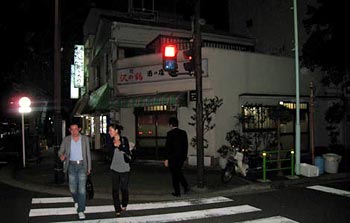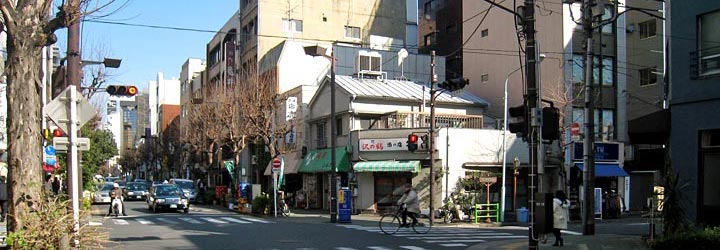- Yummy top
- Eateries and restaurants
- Uoyu - lunch restaurant
- Kanno
- Tokachiya
- Kitchen Nankai - Jinbocho
- Lamb Meat Tender
- Fujiyoshi - tempura restau.
- Enda - Japanese blue crab
- Fukuda - globefish pot
- Sugimoto
- Fuushi
- Soba restaurant
- Shinano - Akabanebashi
- Juwari-soba Inamuraya
- Ando and Korin
- Toranomon Sunaba
- Izakaya
- subLime and Kakinoki
- Donburi-bachi
- Renka
- Yoshida
- Daini-Chikarashuzo
- Sasagin
- Mugiya - soba izakaya
- Fukube
- Sasashin in Ningyo-cho
- Foreign cuisine
- Pizza Piazza
- Atelier de Fromage
- La Piccola Tavola
- Milieu - salad lunch
- Cafe Moskow - Spanish bar
- Sin Tong Kee
- Sekaihanten
- Miscellaneous
- Cheese & champignon party
- Natural Cheese Contest
- Donburi - rice bowl dish
- Home cooking
- Aji no nanban-zuke
- Spaghetti Carbonara
- Curry rice
Sasashin
2-20-3 Nihonbashi-Ningyocho, Chuo-ku, TokyoTel: 03-3668-2456
Sasashin in Ningyo-cho


Tamahide - When this photo was taken, it was nearly the end of lunch time break and the queue was relatively short. Maybe about 30 people were standing.

Imahan

At the counter of Sasashin.
The plate on this side of the counter belongs to us. Two big red heads of "Kinme-dai" are cooked in soy-sake-suger sauce and fit excellently to sake!
 There is a common understanding among the people living in and around Tokyo as to the character of the various zones of Tokyo. The western districts of Tokyo are held to be modern, trendy and wealthy, while the eastern districts are old-fashioned, unsophisticated and poor. Young people who are keen on fashion go to Shibuya, Harajuku and Kichijoji, but not to Asakusa, Senju and Fukagawa. The real estate price is higher in the west and south-west of Tokyo than in the north and east. Nevertheless, the eastern part of Tokyo has better city planning. There are straight and sometimes broad streets crossing at right angles. In the modern and expensive west, narrow streets and side alleys constitute a labyrinth, where you can easily lose your way.
There is a common understanding among the people living in and around Tokyo as to the character of the various zones of Tokyo. The western districts of Tokyo are held to be modern, trendy and wealthy, while the eastern districts are old-fashioned, unsophisticated and poor. Young people who are keen on fashion go to Shibuya, Harajuku and Kichijoji, but not to Asakusa, Senju and Fukagawa. The real estate price is higher in the west and south-west of Tokyo than in the north and east. Nevertheless, the eastern part of Tokyo has better city planning. There are straight and sometimes broad streets crossing at right angles. In the modern and expensive west, narrow streets and side alleys constitute a labyrinth, where you can easily lose your way. The difference between the west and east originates in the construction of Edo - the old name for Tokyo - at the beginning of the 17th century. Merchants and artisans were allowed to live only in the newly reclaimed land in the east, while the western part was reserved for the palaces of feudal lords in Edo and in the further west there were only agricultural fields with narrow and winding agricultural roads.
Therefore, if you go on gourmet tours, you should go to the east of Tokyo. While the restaurants are mostly new buildings and occasionally parts of big capital chains in the west, we can still find many old and private owned restaurants in the east. Some of the restaurants were already in business as far back as the 18th and 19th century and keep their forefathers' taste.
Ningyo-cho is a sort of backyard for Nihonbashi and is one of those interesting spots in the east. The most famous restaurants are Imahan and Tamahide. Tamahide opened in 1760 and is now, apart from its expensive menus, famous for oyako-donburi (chicken egg bowl) that is served at lower price for lunch. However, there is always a long, long queue. Imahan opened in 1895 and is a famous sukiyaki restaurant.
However, ordinary business people go to other restaurants, which are not so famous but you neither have to wait so long nor to pay so much.

Sasashin at night
One such example is "Sasa-shin". I am very happy that such an old-style "izakaya" still survives in Ningyo-cho.
Sasashin starts serving at 17:00 and ends already at 22:30. In the house there is a counter at which only about a dozen people can sit and a table for four people. But, a tiny space makes a very comfortable atmosphere for drinkers. Sasa-shin therefore fills up soon after its opening. If you want to sit, drink and eat without waiting outside too long, you should go there before 17:00.
When you are lucky enough to sit on one of the tiny wooden stools, you must be impressed by many big plates put side by side on the counter. You should point at one of the plates and order. Then the necessary amount will be portioned out, warmed, put on a smaller plate and served to you. They have many menus of cooked seafood, which makes me very happy. They can also grill fish and their potato salad is super.
The only small problem is that they serve only one sort of sake, though that is usual for old type izakaya. But, it is not a big problem. The dishes are really tasty and their sake is not bad at all. I ordered cooked unseasonable horsebeans, potato salad, cooked "kinme-dai" and squid. I thought I ordered a lot, but the price was unexpectedly low - only some $20.

Amazake-yokocho in the daytime. Sasashin is the small wooden house at the corner of a crossroads

Pamphlet of Jusaburo atelier.
 Sasashin is located in a street called "Amazake-yokocho" which leads from Ningyo-cho to Hama-cho and there are many other interesting shops and restaurants. "Amazake" means a sweet hot drink made from sake lees and "yokocho" means an alley. This nickname for the street came from a big amazake shop that existed in the 19th century.
Sasashin is located in a street called "Amazake-yokocho" which leads from Ningyo-cho to Hama-cho and there are many other interesting shops and restaurants. "Amazake" means a sweet hot drink made from sake lees and "yokocho" means an alley. This nickname for the street came from a big amazake shop that existed in the 19th century."Ningyo" of "Ningyo-cho" means doll or puppet. The naming of Ningyo-cho came from the fact that there were puppet theaters in the neighborhood during the Edo period (1603-1867) and many craftsmen gathered here and lived on making and repairing puppets for the theaters.
It is just a coincidence that a famous doll creator Jusaburo has his atelier and tiny gallery in Ningyo-cho. It is worth looking at his dolls and watching him working on his dolls.
There will be another report from Ningyo-cho!
